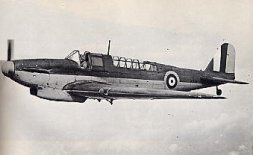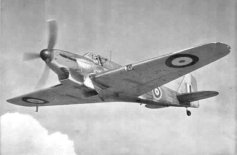
Fairey Fulmar
Developed from the P.4/34 light bomber project, which was eventually abondoned, the Fulmar filled the Royal Navy's desperate need in the late 1930s for a modern monoplane fighter.
Because of a lack of precision navigational instruments, the FAA deemed it necessary for their new fighter to have a second seat to accommodate a navigator, and thus ensure a return to an aircraft carrier in any weather. Although slower and more cumbersome than its single seat land based counterparts, the Fulmar was an excellent aircraft considering the design constraints.
Entering service in 1940, the Fulmar Mk I was soon in action protecting the vital supply convoys to the beleaguered island of Malta. During autumn 1940, Fulmars from No. 806 Squadron were especially busy, managing to shoot down to 10 Italian bombers as well as downing six enemy fighters, while giving cover to the famous Swordfish raid on Taranto.
In addition to fighter duties, Fulmars were also engaged in the fleet reconnaissance role, most notably against the Bismarck and a number of the later, more powerful Mk IIs were modified to become night fighters.
Designed in the 1930s, when Britain's Fleet Air Arm desperately needed new warplanes, the Fulmar was handicapped by Royal Navy demands for twin seat fighters. Underpowered and with modest manoeuvrability and rate of climb, the Fulmar could be easy prey for a seasoned enemy fighter pilot. Yet with heavy armament and a robust structure, the Fulmar did achieve notable success, particularly in the Mediterranean theatre.
 |
 |
 |
| As the best FAA fighter of 1940-42, the Fulmar had good range and firepower, but lacked the speed and agility of single seat fighters. |
With its excellent endurance, the Fulmar was used as a carrier borne spotter. In 1941, Fulmars successfully located and trailed the Bismarck. |
The Fulmar was developed from the P.4/34 day bomber project which was abandoned in 1936. |
|
Fairey Fulmar (Technical Specification) |
| Role |
Two seat carrier-based fighter |
| Manufacturer |
Fairey |
| Maximum Speed |
398 kmh (247 mph) |
| Ceiling |
6,555 meters (21,500 feet) |
Weight
Empty
Maximum Takeoff |
3,955 kg (8,700 lbs)
4,853 kg (10,677 lbs) |
Dimensions
Wingspan
Length
Height
Wing Area |
14.14 meters (46 ft, 5 in)
12.24 meters (40 ft, 2 in)
4.27 meters (14 ft)
31.77 square meters (342 sq ft) |
| Engines |
One Rolls Royce Merlin VIII 12 cyclinder Vee piston engine which provides 805-kW (1,080 hp) |
| Armament |
Eight 7.7 mm (0.303 in) machine guns in wings |
Photo Gallery
Click here to submit your photo
| Have A Passion For Aircraft? |
Subscribe to our 14 series FREE newsletter
delivered weekly on World War 2 Aircraft factfile... |
| NB:- We hate spam as much as you do, so your email address will NEVER be shared with or sold to anyone else. That's a Guarantee. |
|
|





